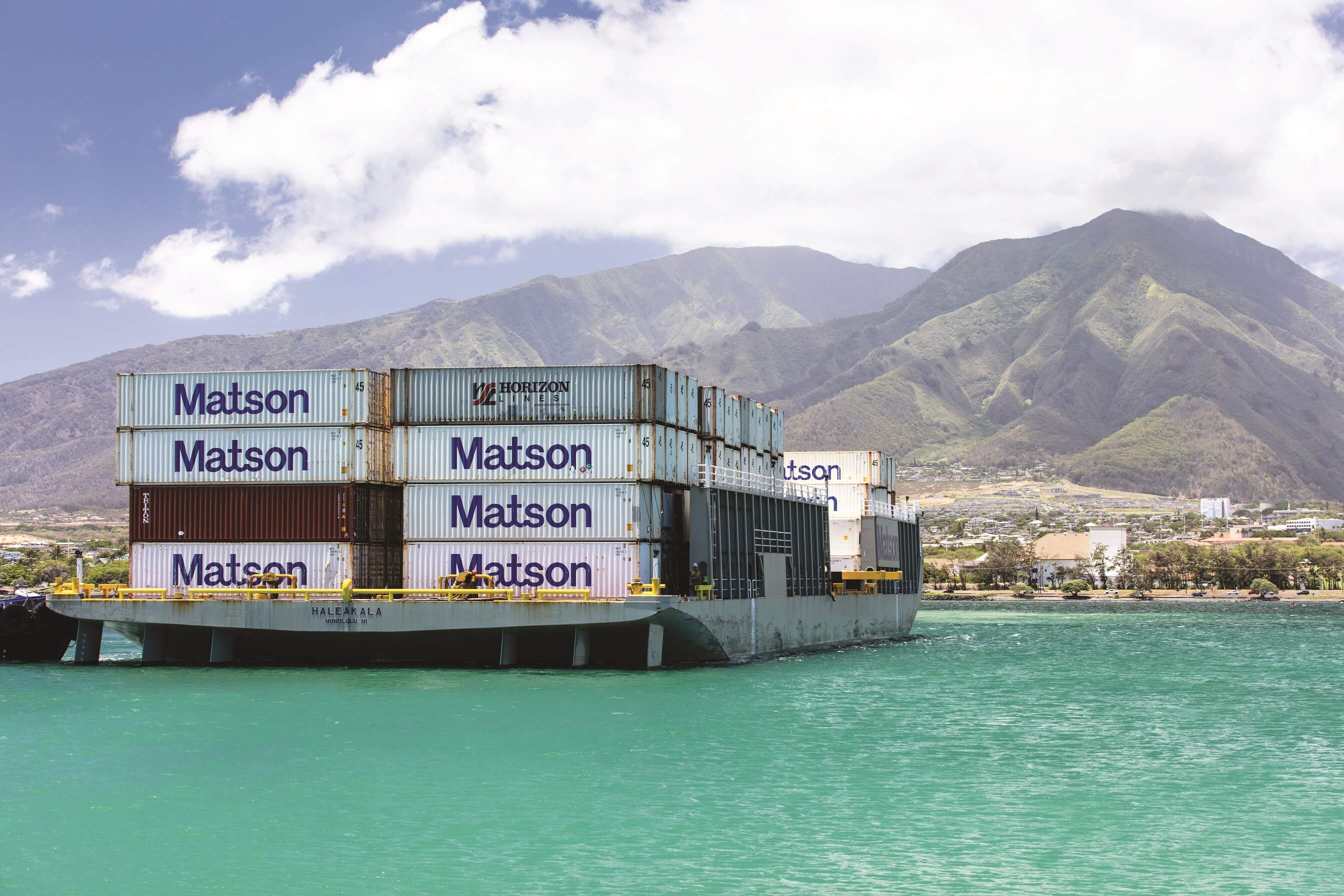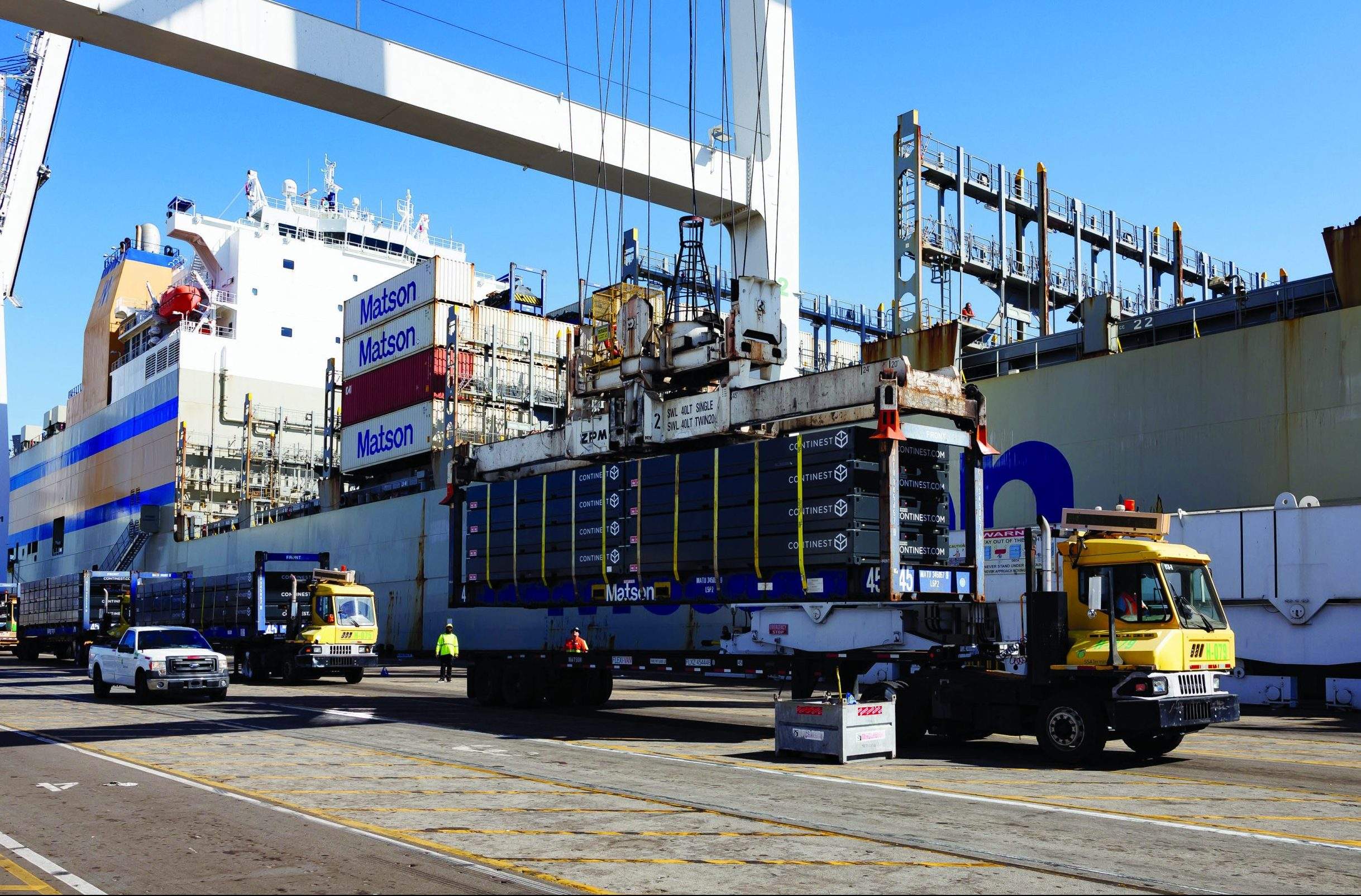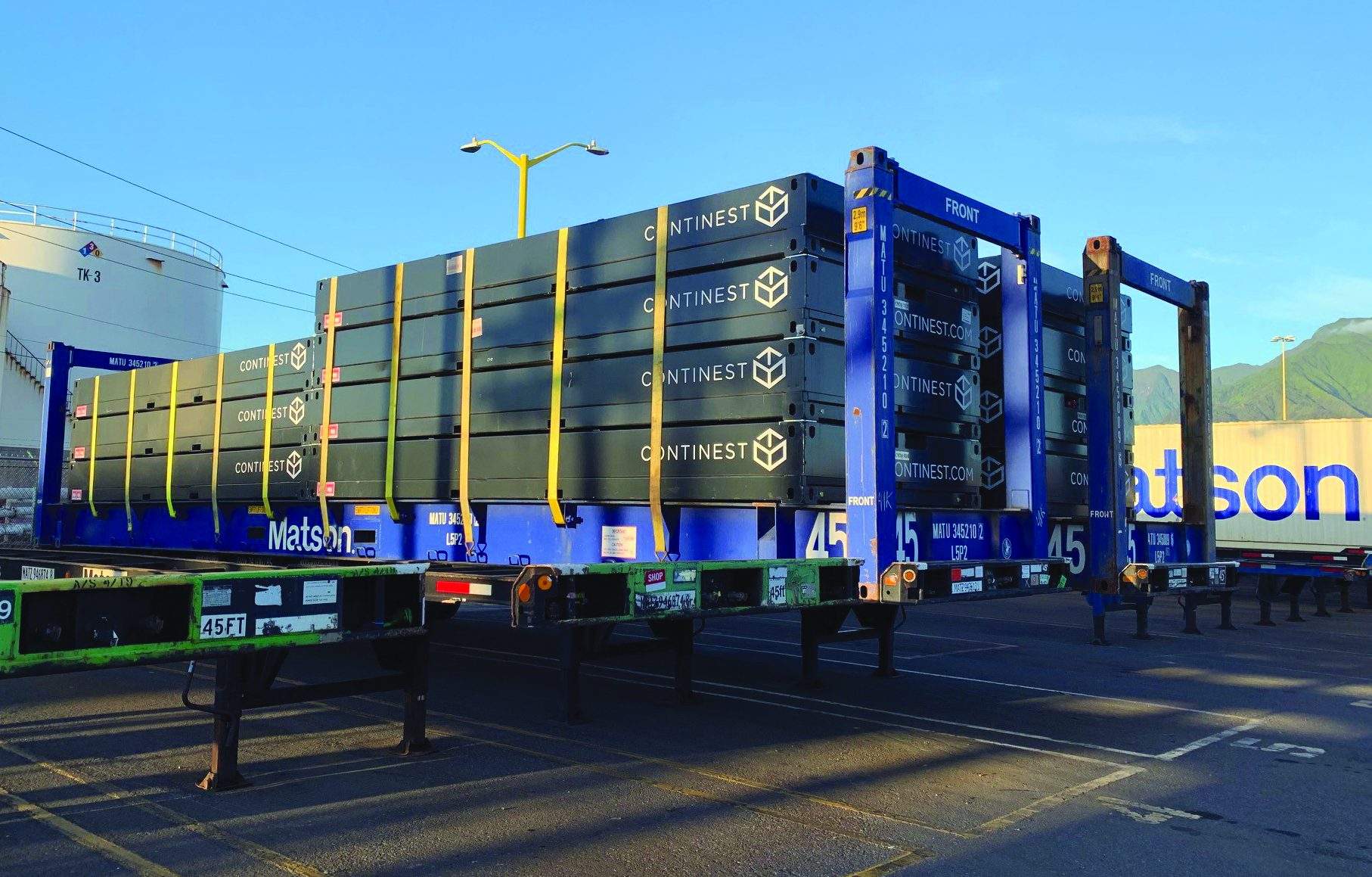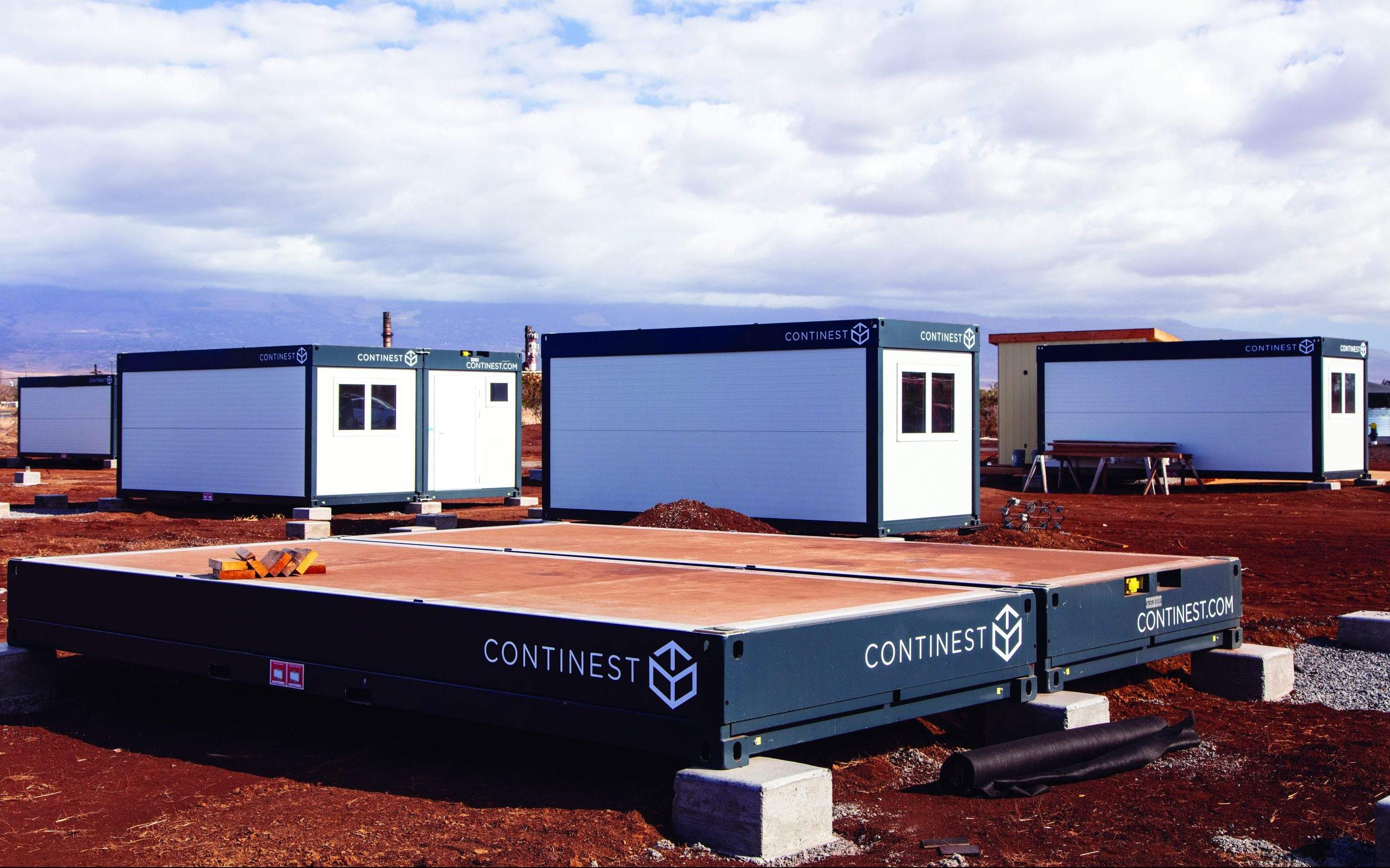
Swift, Sustained Response to Maui Tragedy
Swift, Sustained Response to Maui Tragedy

The day after a massive and deadly wildfire on Maui that destroyed the historic town of Lahaina, more than 2,000 buildings, and resulted in nearly 100 deaths, Matson began mobilizing resources that would be needed to respond to the crisis and sustain the community.
Thousands of residents had evacuated with little more than the clothes on their backs, and immediate needs for food, shelter, and medical care would soon overwhelm local resources.
“Within 24 hours of the fires starting, Matson had reached out to the Hawaii Emergency Management Agency, American Red Cross, Salvation Army, and Hawaii Foodbank to coordinate response efforts,” said Ku‘uhaku Park, senior vice president, Government & Community Relations. “Our neighbor island barge Haleakala had just returned from dry dock, and even without knowing what the level of need would be, we decided to extend the charter of its replacement barge, Columbia, for another month, just to ensure that we had extra capacity available to serve the emergency response and recovery efforts.”
Park chaired an internal Maui response coordination meeting on Zoom – daily for the first two weeks and twice weekly until fast-changing circumstances in the community began to slow just recently. At these meetings, Maui District Manager Buzz Fernandez and Kahului Terminal Manager Randy Bell updated Commercial and Operations division leaders on the latest local developments and planning information received from government and community response organizations, and the group reviewed information on requests for transportation assistance that were arriving daily through various channels.
Matson worked closely with Federal, State, and County emergency response agencies to prioritize shipments of emergency supplies and equipment, while Matson Logistics, the lead logistics provider for the Federal Emergency Management Administration (FEMA) in the Hawaii/Pacific region, provided logistics coordination. Ensuring adequate capacity and timely delivery of relief cargo was Matson’s top priority. Fortunately, Maui’s main port at Kahului Harbor was unaffected by the fires.
“In addition to our twice-weekly service to Kahului, extra barge sailings were added to the schedule to accommodate necessary FEMA emergency supplies,” Bell explained. “The first three extra sailings carried 32 large generators, two 30,000-pound units, one 84,000-pound trailer generator set, and four 40-foot containers of bottled water. In all, approximately 300 containers of crisis-related supplies were delivered to Kahului – in addition to our normal deliveries which continued unabated. Terminal gate hours continue to be extended on arrival days, and weekend access was provided in August to accommodate the additional activity.
“Everyone stepped up and took on more responsibility during the crisis. Russell Phillips managed the day-to-day port operations while I was occupied with emergency relief efforts. Donald Dudoit maintained our disaster equipment and the flood of additional clerical responsibilities resulting from the disaster relief efforts.”
John Lemieux, director, Strategic Accounts, Matson Logistics, added “The incredible Honolulu team made it possible to set up a dedicated barge to handle the huge shipment of generators and supplies for FEMA from Oahu to Maui. Our Hawaii truckers bent over backward to prioritize the movement of the generators, and the Honolulu Container Freight Station team worked tirelessly to accommodate all the priority cargo and secure it for expedited sailing.”
A Flood of Donated Goods
Tim Kirchhoff, director, Sales and Marketing Southwest Region, was tapped to help review all the private sector and nonprofit requests for transportation assistance and supervise the booking and movement of all Maui emergency response and relief shipments off the West Coast.
“During the early weeks of the crisis, there was a lot of uncertainty,” Kirchhoff said. “Information was slow to arrive regarding which sites or projects were authorized to start moving. Regardless, Matson worked with shippers to make sure they understood that we were ready to tackle whatever needed to be done.
“The West Coast Operations team – Mike Renshaw (terminal operations manager, Tacoma) and Eamonn Oley (general manager, Southern California Operations), were instrumental in making these moves happen. The people in Hawaii, Bryson Kashiwaeda (supervisor, Container Operations), Greg Chu (general manager, Container Operations), and Buzz Fernandez have all been fantastic. There has been a tremendous sense of wanting to do the right thing for those affected by the fires. The teamwork at Matson, while always strong, has been even more impressive during this response.”
Sheltering Survivors

One of the critical immediate challenges resulting from this crisis has been providing shelter for displaced survivors. Approximately 1,000 families are in need of housing, and many of the homes lost were low-income housing. Claire Hasl, senior director, Customer Service, and Caryn Buckland, supervisor, Customer Service, have personally handled the coordination and booking of shipments involving a variety of housing solutions, from domes to tents to prefab tiny homes. Hungary-based Continest Technologies is providing 200 fully wired pop-up homes to house fire victims. The units were trucked from New Jersey with two drivers per truck, to make the cross-country trip to Long Beach in just four to five days, where they are being loaded to Matson vessels for the final leg to Maui, via Honolulu.
All of the units are expected to ship by late October. Maui nonprofit Family Life Center secured the loan of a 10-acre site in Kahului for the dwellings from local church King’s Cathedral and requested Matson’s assistance in delivering them to Maui. Kirchhoff, Hasl, Buckland, Fernandez, and our Long Beach Terminal Operations team have all coordinated the moves personally, to ensure their smooth and timely delivery.

Working on the ground on Maui, Shannon McCandless and Mikki Branding, supervisor, Customer Service, and team lead, Customer Service, Phoenix, were brought in to help manage the flood of requests from responding agencies, nonprofit organizations, and individuals wanting to help and to coordinate local efforts to fulfill requests from crisis responders.
“I was brought out to assist with face-to-face customer contact and tracking of physical assets in the community, working with customers on in-kind donation requests and coordinating with FEMA, non-government organizations, and local businesses regarding the pickup and return of equipment,” said McCandless. “I also met with contacts regarding the cleanup of hazardous materials and assisted with local housing projects. Mikki assisted with tracking and coordinating the movement of disaster relief support containers and returns. By maintaining communication with disaster relief coordinators, Mikki ensured that equipment requirements were met, while supporting the terminal with numerous duties, including the release of containers for prompt out-gating.

“Most of our activities could not have been done remotely because phone service was spotty or in some cases, nonexistent due to damaged or destroyed cell towers, so communications had to take place in person,” continued McCandless. “Customers would often come into the office seeking assistance. Other times we would meet them onsite somewhere in the community,” she said, adding that all of this activity was coordinated with Buzz Fernandez, Donna Ka‘imikaua in Sales as well as Randy Bell, Russell Phillips, and Donald Dudoit in Terminal Operations, and reported to internal counterparts on the Phoenix, Hawaii Sales and Operations teams, as well as the executive team.
With the community moving beyond the initial crisis response into recovery, Federal authorities have begun the first phase of clearing the disaster site with the removal of household hazardous materials (“Hazmat”) such as paints, cleaners, solvents, oils, batteries, and pesticides. The County of Maui recently approved the use of “Soiltac,” a biodegradable polymer product and soil stabilizer that prevents runoff of hazardous materials into the ocean and surrounding streams/rivers. These hazardous materials will be shipped to processing facilities on the West Coast while the U.S. Army Corps of Engineers works with local officials to develop a plan to dispose of an estimated 400,000 to 700,000 tons of debris on the island.
“Phase 1 of the recovery and aboveground cleanup efforts are still ongoing with about 66 percent completion as of October 11,” said Buzz Fernandez. Matson expects to begin carrying Phase 1 Hazmat shipments this month and continue supporting this phase for the next six to 12 months.”
Phase 2 will be the removal of destroyed cars and building materials, however, the Army Corps and Federal authorities have yet to declare a start date for Phase 2. There is a lot of sensitivity surrounding anything of cultural significance. Native Hawaiians from Maui will act as cultural monitors during the cleanup of Lahaina, working with the EPA and the Army Corps to ensure that anything of cultural significance is handled with the utmost care.
As Maui begins the long road to recovery, Matson continues to play an important role.
“Everyone at Matson has contributed to helping the entire Maui community respond to this crisis, and we will continue to do so throughout the recovery effort,” said Fernandez.
